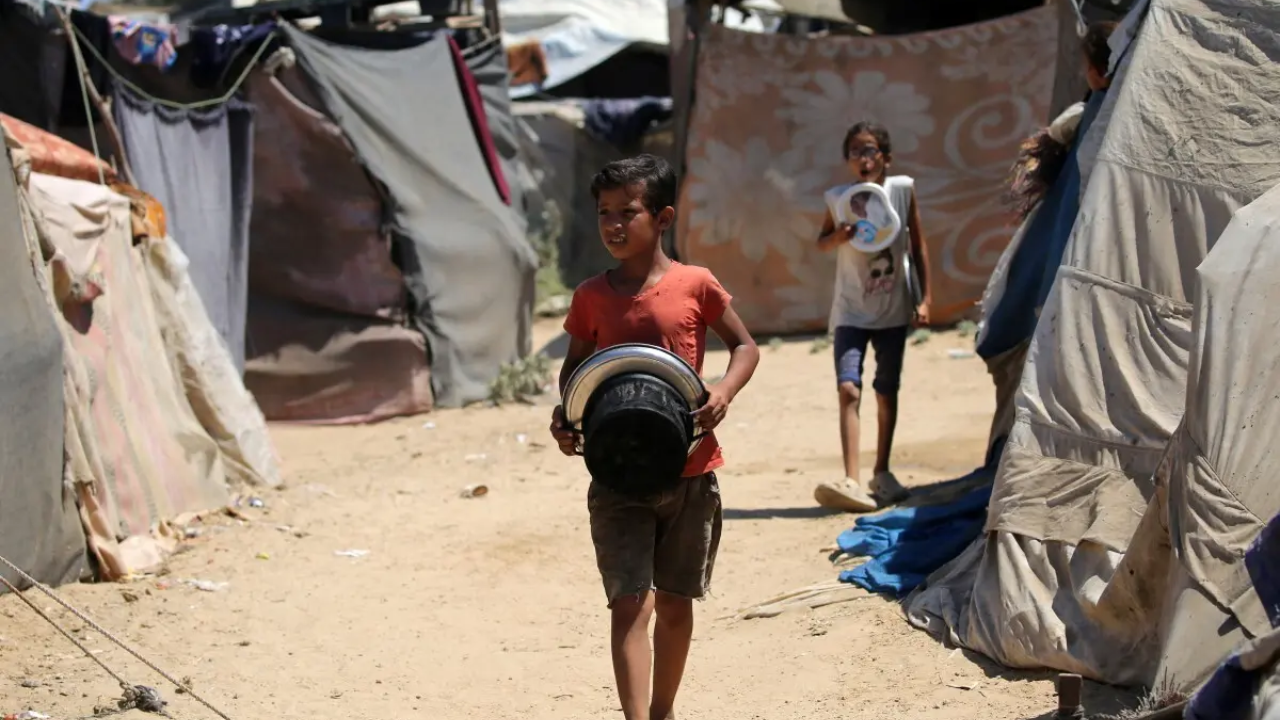In Gaza, a region devastated by conflict, numerous young children are suffering from serious medical conditions, including hepatitis and various skin ailments. These health problems are primarily attributed to the scarcity of clean water suitable for drinking and bathing purposes.
The dire situation has left many children vulnerable to preventable illnesses, as the lack of access to safe water sources continues to pose a significant threat to their well-being.The ongoing war has severely impacted the region’s infrastructure, making it difficult for families to obtain the clean water necessary for maintaining proper hygiene and health.
Gaza’s water infrastructure, including desalination plants and water wells, has been severely damaged since the war with Israel. According to NBC News, Oxfam International reported that all desalination plants and 88% of water wells have been destroyed or damaged, along with all wastewater treatment plants and 70% of sewage pumps.
As a result, the available water in Gaza has dropped by 94%, leaving residents with less than 5 litres per person daily.
Humanitarian organisations are working to repair infrastructure, install septic tanks, and distribute clean water and chlorine tablets, but their access to the area is limited.
Residents are forced to consume and bathe in untreated seawater contaminated with sewage, without access to soap or disinfectants. This has led to a significant increase in cases of hepatitis A, acute respiratory infections, acute diarrhoea, jaundice, skin rashes, and scabies.
The United Nations has reported efforts to restore electricity to a desalination plant in southern Gaza, which could provide clean water to approximately one million people.
However, the health threats associated with contaminated water continue to escalate, with the polio virus being detected in wastewater samples in June.
Although no new cases have been confirmed, the World Health Organization warns of a high risk of polio spreading in Gaza, as the virus can be transmitted through drinking water contaminated with faeces from an infected person.
According to health officials, skin diseases are spreading rapidly in Gaza. They attribute this to the deplorable conditions in overcrowded tent camps housing hundreds of thousands of displaced Palestinians, along with the summer heat and the breakdown of sanitation, resulting in pools of open sewage amid Israel’s 10-month bombardment and offensives in the territory.
The World Health Organization reports that doctors are dealing with over 103,000 cases of lice and scabies and 65,000 cases of skin rashes. The United Nations Development Program says that among Gaza’s population of approximately 2.3 million, more than 1 million cases of acute respiratory infections, over half a million cases of acute diarrhea, and more than 100,000 cases of jaundice have been recorded since the war began.
Palestinians say that maintaining cleanliness is impossible in the makeshift tents, which are essentially wood frames covered with blankets or plastic sheets, packed closely together over large areas.
Over 1.8 million of Gaza’s 2.3 million residents have been forced from their homes, often relocating multiple times in the past months to escape Israeli ground assaults or bombardment. The majority are now crowded into a 50-square-kilometre area of dunes and fields on the coast with virtually no sewage system and limited water.
UN officials report that the distribution of humanitarian supplies, including soap, shampoo, and medicines, has slowed to a trickle because Israeli military operations and general lawlessness in Gaza make it too dangerous for relief trucks to move.
“Israel launched its campaign vowing to destroy Hamas after its October 7 attack on southern Israel, in which some 1,200 people were killed and 350 abducted. Israel’s assault has killed more than 39,000 people, according to Gaza health authorities.”
The dire situation has left many children vulnerable to preventable illnesses, as the lack of access to safe water sources continues to pose a significant threat to their well-being.The ongoing war has severely impacted the region’s infrastructure, making it difficult for families to obtain the clean water necessary for maintaining proper hygiene and health.
Gaza’s water infrastructure, including desalination plants and water wells, has been severely damaged since the war with Israel. According to NBC News, Oxfam International reported that all desalination plants and 88% of water wells have been destroyed or damaged, along with all wastewater treatment plants and 70% of sewage pumps.
As a result, the available water in Gaza has dropped by 94%, leaving residents with less than 5 litres per person daily.
Humanitarian organisations are working to repair infrastructure, install septic tanks, and distribute clean water and chlorine tablets, but their access to the area is limited.
Residents are forced to consume and bathe in untreated seawater contaminated with sewage, without access to soap or disinfectants. This has led to a significant increase in cases of hepatitis A, acute respiratory infections, acute diarrhoea, jaundice, skin rashes, and scabies.
The United Nations has reported efforts to restore electricity to a desalination plant in southern Gaza, which could provide clean water to approximately one million people.
However, the health threats associated with contaminated water continue to escalate, with the polio virus being detected in wastewater samples in June.
Although no new cases have been confirmed, the World Health Organization warns of a high risk of polio spreading in Gaza, as the virus can be transmitted through drinking water contaminated with faeces from an infected person.
According to health officials, skin diseases are spreading rapidly in Gaza. They attribute this to the deplorable conditions in overcrowded tent camps housing hundreds of thousands of displaced Palestinians, along with the summer heat and the breakdown of sanitation, resulting in pools of open sewage amid Israel’s 10-month bombardment and offensives in the territory.
The World Health Organization reports that doctors are dealing with over 103,000 cases of lice and scabies and 65,000 cases of skin rashes. The United Nations Development Program says that among Gaza’s population of approximately 2.3 million, more than 1 million cases of acute respiratory infections, over half a million cases of acute diarrhea, and more than 100,000 cases of jaundice have been recorded since the war began.
Palestinians say that maintaining cleanliness is impossible in the makeshift tents, which are essentially wood frames covered with blankets or plastic sheets, packed closely together over large areas.
Over 1.8 million of Gaza’s 2.3 million residents have been forced from their homes, often relocating multiple times in the past months to escape Israeli ground assaults or bombardment. The majority are now crowded into a 50-square-kilometre area of dunes and fields on the coast with virtually no sewage system and limited water.
UN officials report that the distribution of humanitarian supplies, including soap, shampoo, and medicines, has slowed to a trickle because Israeli military operations and general lawlessness in Gaza make it too dangerous for relief trucks to move.
“Israel launched its campaign vowing to destroy Hamas after its October 7 attack on southern Israel, in which some 1,200 people were killed and 350 abducted. Israel’s assault has killed more than 39,000 people, according to Gaza health authorities.”
Source : Times of India






